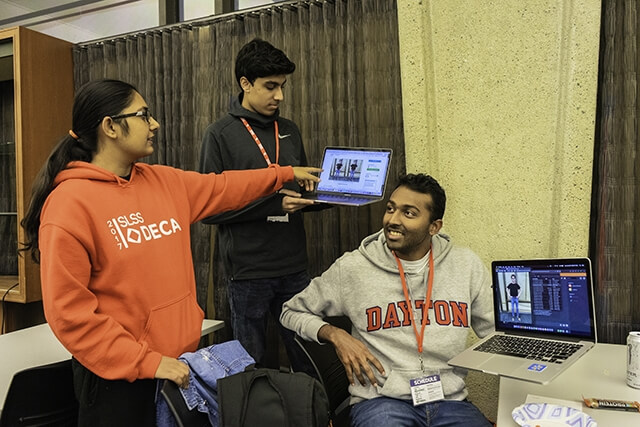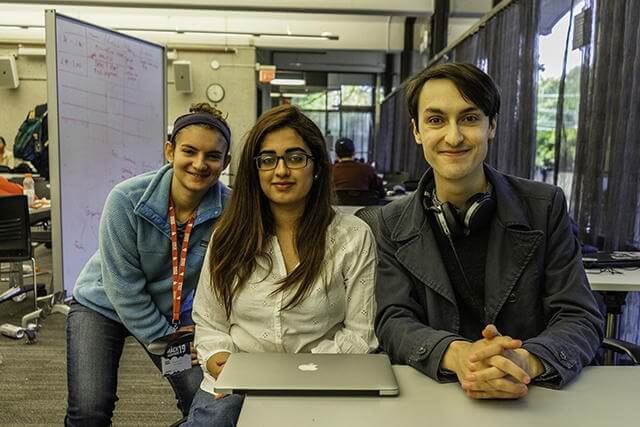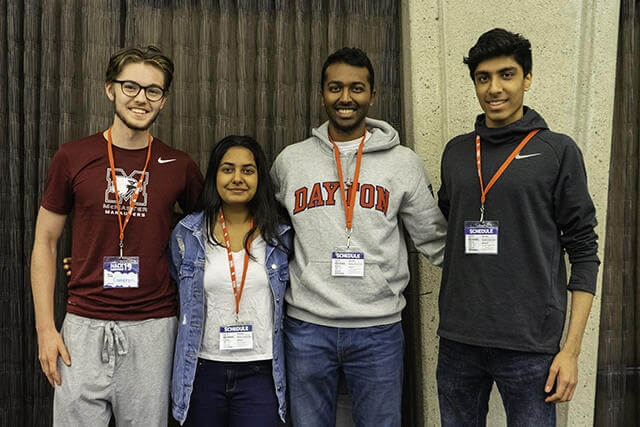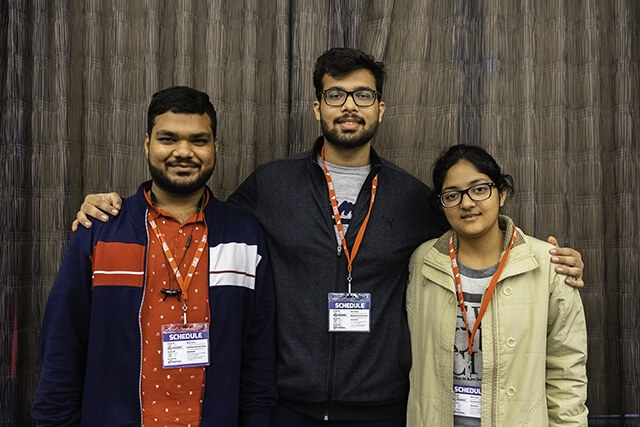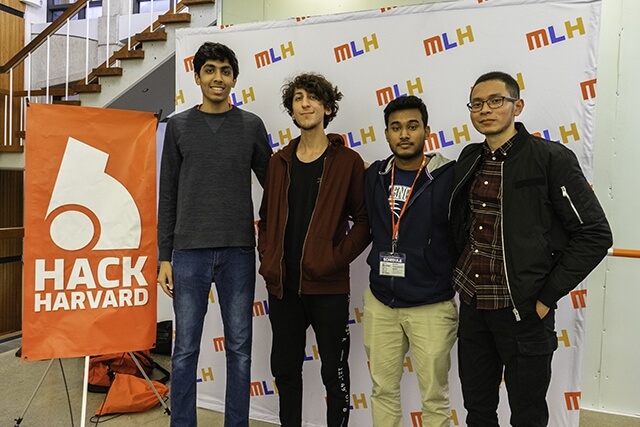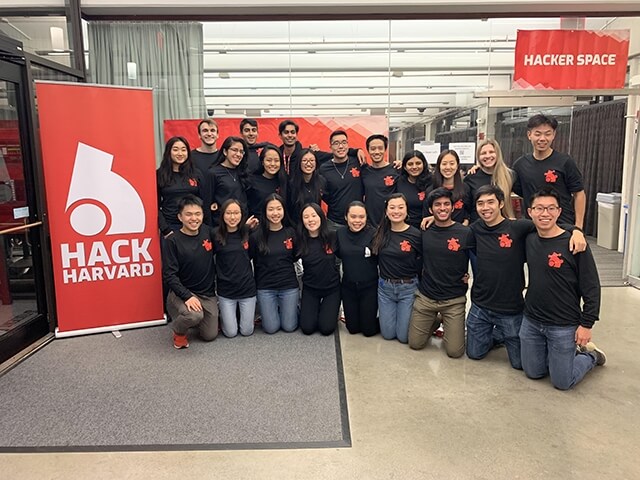News
Members of a HackHarvard team explain their project, a virtual fitting room to bridge the gap between the convenience of online shopping and the experience of retail shopping. (Photo by Jiayin Lu/SEAS Communications)
The fifth annual HackHarvard invited students from the Harvard John A. Paulson School of Engineering and Applied Sciences and beyond to explore the intersection of technology and society by building projects over the course of the 36-hour hackathon.
The HackHarvard team focused on providing quality and accessibility to people who had never touched a line of code. One third of attendees were non-computer science majors and many were first-time hackers.
HackHarvard encouraged participants to focus on communicating about the technology they built by instituting a block of time between code submission and the judging rounds. Hackers took advantage of the opportunity to rehearse their pitches, and some teams even produced flyers to advertise their products.
Mohib Jafri, S.B. ’21, an electrical engineering concentrator and one of the HackHarvard organizers, emphasized the importance of developing communication skills alongside technical skills.
“Technology is made not only to be built but to be shared. The image of the hacker is no longer someone hunched over code, but rather a public speaker and leader who creates impactful products,” he said.
Act Now team members (from left) Stephanie Ginovke, a computer science major at the University of Chicago, Noor Fatima, a computer science major at Haverford College, and Owen Leddy, a biological sciences Ph.D. students at MIT. (Photo by Jiayin Lu/SEAS Communications)
Inspired by a desire to help people channel their anxiety about current events into action, Act Now built a Google Chrome extension to showcase opportunities for readers to take action on issues raised by news articles. In a demonstration, the team showed how a user could navigate to a news article and a relevant banner would appear offering information about events or opportunities to donate to support the cause, such as a donation link to The Bail Project that would appear on an article about mass incarceration. The team built their product from a web scraper that passes the contents of a news article into a keyword finder that identifies high frequency words and matches those with organizations’ key words. In the future, the team envisions that their product could be a decentralized platform for organizations to log in and upload key words from their missions to connect people to their communities.
Owen Leddy, a first-year biological engineering Ph.D. student at MIT, hopes this project will create greater opportunities to contribute to causes.
“I was inspired by a talk I heard about meeting communities where they are,” he said.
Team UFIT (from left) Cameron Orr, a software engineering major at McMaster University, Mahnoor Tariq, a software engineering major at McMaster University, Vigwesh Krish Naraja, a computer science major at the University of Dayton, and Ayman Kamran, a computing and financial management major at the University of Waterloo. (Photo by Jiayin Lu/SEAS Communications)
UFIT
UFIT created a virtual fitting room to bridge the gap between the convenience of online shopping and the experience of retail shopping. The team used a machine learning model that was pretrained to plant markers on a human body that correspond to sizing measurements for clothing. When users upload photographs of themselves, the tool superimposes a scaled image of the clothing onto the user’s image, connecting the image of the clothing with the markers placed on the body.
“We thought this project literally fits the theme of connecting the dots,” said Ayman Kamran, ’22, a computing and financial management major at the University of Waterloo.
Team Easylexia (from left) Divyansh Agarwal, an electronics major at VIT Vellore India, Kanupriya Agarwal, a biotechnology major at VIT Vellore India, and Garvit Bhateja, an electronics major at VIT Vellore India. (Photo by Jiayin Lu/SEAS Communications)
Easylexia
Easylexia created an app to help make learning more accessible for people with dyslexia, a learning disorder that involves difficulty reading. To serve this need, the team’s app enables users to type answers to questions and then press a button to play what they wrote aloud. Easylexia built an array of features to make learning an engaging experience through gamification and music.
The team traveled for 15 hours to arrive at Harvard. Once here, they found the hackathon to be a worthwhile experience that helped them meet new people and learn to tackle tough challenges in an exciting atmosphere.
Team Healthband (from left) Ammar Kamrah, a computer science and finance major at the University of Waterloo, Papoiz Haonidod, a computer science major at Adelphi University, Rishabh Shrestha, a computer science major at the University of Mississippi, and Richard Mahuze, an engineering systems master's student at Cornell University. (Photo by Jiayin Lu/SEAS Communications)
HealthBand
Recognizing the breadth of health concerns for elderly patients, HealthBand set out to build a full package solution for health emergencies and long-term health tracking. Through their product and smartwatch enabled solution, the team’s mission is to offer “health at your fingertips.”
For health emergencies, the team worked to build a machine learning model trained to monitor blood pressure to detect heart attacks with 78 percent accuracy, taking into account natural changes in blood pressure, such as the decrease that occurs during sleep. In such an emergency, the HealthBand product would notify family members, health care providers, and 911 with an update on the user’s specific location. The user’s smartwatch would feature a QR code that a bystander could scan to access the user’s medical alert card.
For long-term health tracking, the team focused on chronic disease management for elderly patients. They built a website that could be used to store all family medical history, as well as medical files and tests. Recognizing the importance of exercise, the team added a smartwatch feature that would track steps taken and notify users to take a walk after a long sedentary period. Another feature sends reminders for taking medications.
Ammar Kamran, who studies computer science and finance at the University of Waterloo, said his brother’s severe allergies inspired the inclusion of a QR code linked to a medical alert card. Severely allergic patients need to carry medical alert cards at all times, but they may not always have the card with them in an emergency and even if they do, bystanders may not know to look for it. Kamran hopes that the QR code will solve that problem, saving valuable time in an emergency.
“We’re really passionate about HealthBand, and we are going to coordinate to keep working on it even beyond the hackathon from our different cities,” he said.
Topics: AI / Machine Learning, Computer Science
Cutting-edge science delivered direct to your inbox.
Join the Harvard SEAS mailing list.
Press Contact
Adam Zewe | 617-496-5878 | azewe@seas.harvard.edu
